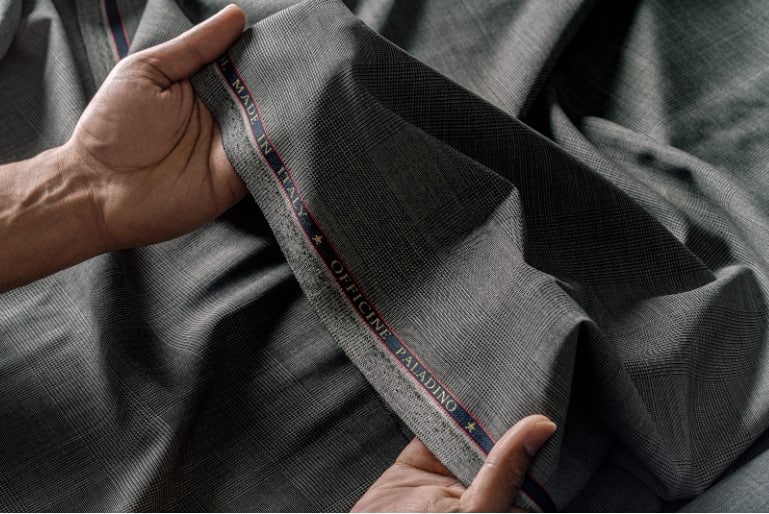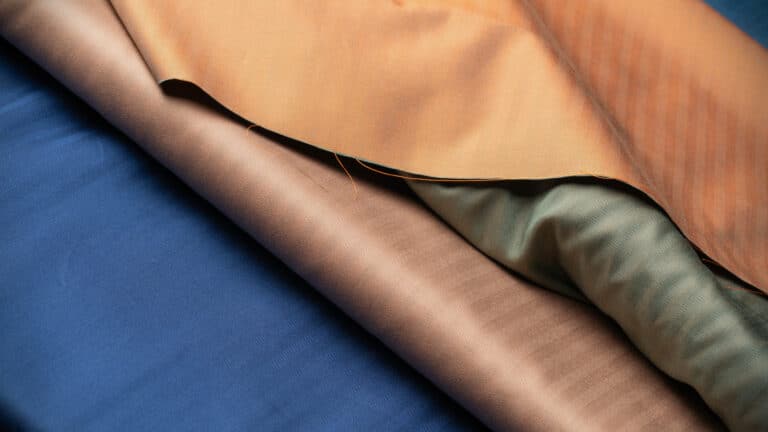When you’re making a bespoke suit or customizing an outfit with a tailor, picking the right fabric is essential, it’s important to understand the differences between different fabrics to find the right material for your next tailored fit. In this men’s guide for suit fabrics, we give you the lowdown on how to select the best fabric for your next suit:
- Learn the key factors to help you select the right suiting fabric, such as the occasion you’re tailoring it for, the drape and feel and the comfort of the cloth.
- Understand how the fabric choice has an effect on suiting, and how it needs to match your style and fit.
- Discover the common types of suiting fabrics — wool, cotton, and linen — and the qualities they give your suit.
- Find out how to distinguish between the different types of weaves in fabrics and what that means for your suit.
- Learn what the thread count in wool means and why that matters for your suit.

Ed wears a grey Super 130’s wool suit tinged with green, using the Coventry OP 2160 fabric.
What to look out for when choosing a suit fabric type
Designing the suit you want starts with choosing the right fabric for your look. For example, our plain weave Italian suiting fabrics are ideal for the Neapolitan style of tailoring which favors soft shoulders, long darts for a streamlined look and better fit, and minimal lining so the jacket always fits well. The best fabrics for suiting offer a great handle so that it’s easy for the tailor to cut and shape, while providing a luxurious soft touch for the wearer. The types of weaves used to create the fabric, and the material of the yarn also helps to determine the qualities of your suit. That’s why we recommend different types of suit fabrics for different moments in your life.
Occasion
Formal occasions such as a wedding or a black-tie gala call for a finely woven fabric. For such events, we’d recommend a twill weave or faille weave wool, which offer a sophisticated look and feel. Consider a higher S-number when selecting such a wool, or a wool-silk blend which adds a luxurious sheen to the fabric. For every day suiting, the choice of a fabric for suiting depends on the conditions. In a more humid environment, you may wish to select a lighter, breathable material such as cotton, linen or a hopsack weave wool. Otherwise, a plain weave Super 120’s or 130’s provides the right balance of comfort and sartorial style for the office. Cooler climates may favor a twill weave wool.
Feel
The handle of the suit fabric impacts how it feels and moves when you wear it. A classic handle provides a more structured suit, ideal for formal suiting. It also means the suit is less likely to crease. A suit fabric with a lighter handle creates a more relaxed fit, but tends to crease more easily when worn. In wool fabrics used for suiting, a higher S-number such as a Super 150’s offers a softer finishing and greater luster, but has a more relaxed handle, while Super 130’s provides good durability with more structure.
Comfort
The texture and feel of a luxury suiting fabric is determined by the weave and type of yarn used. For example, cotton is mercerized before it’s made into yarn in order to help it absorb dyes better, add luster and give the fabric a softer touch. In comparison, linen has a slightly different texture due to the looser plain weave it’s produced with. Most plain weave suit fabrics have a soft touch that means it’s highly comfortable when worn. Some twill weave fabrics tend to have a coarser texture, unless they are specially designed with a soft touch such as our Eco-Evolution twill weave fabrics. Breathability is also a factor when it comes to comfort. All natural fiber fabrics such as wool, cotton and linen are highly breathable, which is why we use them exclusively for our suiting fabrics.
What your next tailored suit will be for
Before we dive into the different types of fabrics used in tailoring, let’s consider why you’re making your next outfit. Deciding how you will use your outfit helps determine the type of qualities it needs to have and the best material for it.
What’s the occasion?
Different occasions call for different looks and different fabrics. Take the classic tuxedo for example. Designed especially for a formal occasion, the tuxedo’s fabric needs to feel comfortable and look glamorous. The best choice for this is a fabric with a faille weave, which has a distinct cross-ribbing that gives the cloth a silky look. Meanwhile, a suit or outfit meant for daily wear needs a more durable fabric, for which we recommend a plain or twill weave in a sturdier weight. Depending on how you like your suit — be it structured and formal in the English style of tailoring, or more relaxed and deconstructed in the Italian style, we recommend choosing fabrics from each region to match your needs. It’s also important to consider the weather and conditions in which you’d wear your bespoke suit or tailored outfit. For warmer, more humid weather, hopsack wool or cotton or linen cloth is ideal, as they offer breathability and comfort all day long. If it’s meant for cooler weather, a ball of twill-weave wool is an excellent option for your suit.
Your clothing style matters
You must share with your tailor the clothing style you prefer in your daily wear. For example, if you enjoy glossier fabrics, you may want to consider high-quality cotton or wool-silk blend cloth for your next outfit, as they tend to offer brighter colors with a glossy sheen. However, if you prefer matte tones and more subtle hues, a solid color or patterned wool fabric may suit you better. Your clothing style may also determine the type of outfit you’re tailoring — whether it’s a classic suit, safari jacket or chore coat, and the best fabric choice for such a look. A lightweight safari jacket for the summer would work well in cotton, whereas one meant for fall or winter would be better in wool.
The right comfort and fit
Whatever you’re tailoring should make you feel comfortable and fit well, no matter the type of fabric you select. Natural fibers offer the most comfort as they are highly breathable, with some natural stretch so you can move around freely and easily. The texture and handle of a material are determined by different things from the weave to the type of fiber and the producer. English fabrics are known for their lovely handle which drapes well on the body and are naturally quite crease resistant. They are more structured compared with an Italian hopsack or linen. And while linen is ideal for a relaxed fit, it tends to have a slightly coarser texture compared with a soft touch wool. Knowing what you prefer in the texture of the fabric and the way it drapes over your physique determines the type of material and weave you should select.
What are the different types of suiting fabrics
There are several different fabric types that are frequently used in suiting and each vary in the type of qualities they possess. Let’s take a look at some of the most popular.

Wool fabrics such as Latte OP 2152 come with different qualities. Choose the right fabric for your suiting needs.
Wool Fabric
A general term used for animal fibers that’s woven into textiles, wool is most commonly associated with sheep. Other related fibers include cashmere, mohair, alpaca and vicuña. Wool is one of the most common fabrics used in suiting, thanks to its versatility and quality. It’s fully biodegradable and highly sustainable in production today, with longevity in maintaining its quality. That’s why most tailors enjoy working with wool for suits and outerwear.
The quality of wool produced depends on the fineness of the fiber, as well as the length, strength, color and crimp. Long fibers mean that the yarn that can be spun from it will be stronger. The strength of the fiber enables it to be twisted tightly (also known as high-twist wool) which gives it crease resistance and durability.
The S-number used in wool (known as Super, for virgin wool) indicates the diameter of the fiber and therefore how dense it can be woven. A lower number will offer a less dense and more durable fabric, while a higher number offers a very fine fabric that’s also more fragile. What this means is that fabrics like Super 100’s or Super 130’s are ideal for regular wear, while Super 150’s and onwards are better for very formal suiting.
Of course, the S-number doesn’t reflect the finishing of the fabric, which is what offers the fabric its sheen, texture and handle. A Super 100 fabric with a high quality finishing can be as refined as a Super 150’s. What it does indicate is the breathability and sturdiness of the cloth, as well as its natural stretch and to some extent, crease resistance. Today, there are wool fabrics that are imbued with unique qualities such as water and stain repellent benefits as well. Whether you’re looking for a structured, fully canvassed suit or a lightweight, half-canvassed jacket, there will be a wool fabric to meet your needs in our Eco Evolution collection.
For summertime or warmer and more humid climates, a lower S-number wool fabric or a hopsack weave is ideal, as they are highly breathable and comfortable. In cooler climates, a twill weave or finer plain weave wool will keep you looking sharp and warm.
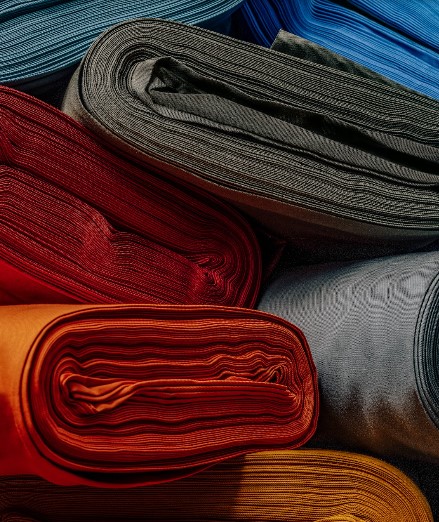
Cotton fabrics are often used for summer suits or casual suiting. They are comfortable and designed for warm climates.
Cotton Fabric
Unlike wool, cotton is a plant-based fiber that grows around the seed of the cotton plant that is spun into yarn. It’s one the oldest fabrics used in clothing and is highly valued for its breathability and durability. It’s the most common natural fabric used in fashion today, from denim to shirting and more. But its best quality is how it’s able to easily absorb dye colors, making it highly desirable in fashion.
As with wool, cotton fibers with a longer length are highly valued and considered to be the finest. They are also graded according to the color which reflects how well they can absorb color. To improve its quality for use in fabrics, it’s mercerized before weaving by treating it with caustic soda to increase its volume and therefore luster, as well as affinity to dyes. This creates a smoother fabric for clothing. The weave of the fabric determines the type of use — denim for example uses a twill weave with a diagonal ribbing. High end cotton fabric is ideal for a lightweight and casual suit or outfit meant for warmer climates.
Most cotton fabrics are soft with a smooth texture and luster, and suitable for a half-canvassed or unlined suit or jacket, as well as pants. If you’re looking for a more structured look, you can consider a double-layered jacket or a fully-lined cotton suit, which will suffice even in the balmy weather of spring or fall.
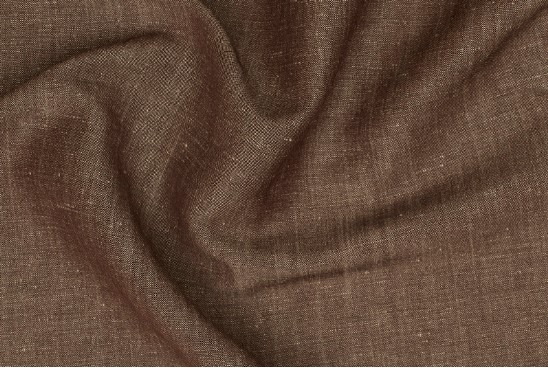
Linen fabrics are highly durable and hypoallergenic, soft and cool to wear, making them highly suited for hot summers.
Linen Fabric
Linen is a plant-based fabric like cotton, but made with fibers from the flax plant. It’s the oldest fiber used in clothing, with a relatively long fiber length that makes it easy to spin into high quality yarn. Like cotton, it’s excellent at absorbing dyes and has a unique quality in that it increases its strength when wet. It also has a much higher durability when compared with cotton, and is hypoallergenic as well. It is a smooth fabric and is cool to the touch. However it has poor elasticity, which makes it prone to breakage and easy to wrinkle.
Linen is measured based on the number of yards per pound, with fine linens measuring 12,000 yard per pound (or 40 lea). Most linens today are not used in suiting, but for fashion accessories or bedding. Linen suits are favored during the summer for their breathability and comfort in humid and dry, hot weather conditions. Soft and flexible, linen is suitable for those looking for a very relaxed style, such as an unlined, deconstructed suit.
Common Types of Fabric Weave Patterns
There are many different types of weaves used to produce fabrics, but only a few common ones in suiting. A fabric is woven using warp or lengthwise threads that are held stationary while the weft or transverse threads go over and under the warp. Different weaving patterns — the number of warps to wefts — dictate the type of weave produced. Here’s how you can tell what weave is used in your suit fabric, and how that affects the qualities of your suit.
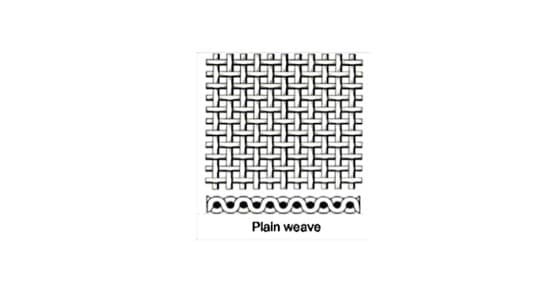
The warp and weft threads in an interlocking pattern used in a plain weave fabric. Image courtesy of F. Kuger.
Plain Weave
The plain weave is the most commonly used, with over half of all suiting fabrics produced in a plain weave. In most plain weaves, every weft goes under and over the warp threads, creating an interlocking check pattern. A looser or tighter plain weave gives the fabric more stretch and breathability or more structure and tension respectively. A variation of a plain weave is the hopsack, where instead of one weft thread interlocking one warp, it’s two wefts and two warps. Another example of a plain weave variant is the faille weave, which uses a heavier weft thread interlocking several warp threads in the plain weave to create a soft, lightweight and glossy suit fabric.
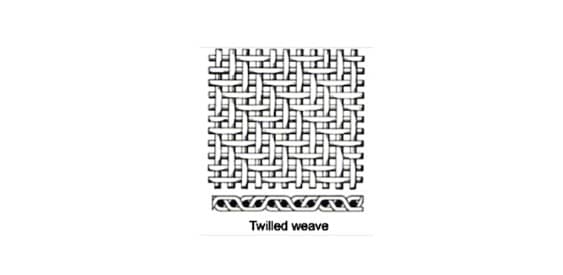
The weft threads in a twill weave fabric go over and under two or more warp fibers and alternates, either from left to right or in the opposite direction. Image courtesy of F. Kuger.
Twill Weave
The twill weave is used in fabrics that have a classic handle and drape, while creating a strong and soft fabric that’s ideal for formal suiting. In a twill weave, weft fibers go over and under two or more warp fibers in an alternating pattern, or vice versa. The number of alternating fibers can vary, which creates different textures and patterns. The effect is a visible pattern of parallel diagonal ribs on the surface of the fabric. If the pattern goes upwards from the left it’s a right-hand twill; if it goes downwards it’s a left-hand twill.
The most famous twill fabric is naturally denim, although others such as gabardine are also well-known. In suiting, the herringbone weave is a fine example of the twill weave pattern, which is also known as a broken twill because it has both right and left-hand twill weaves.
What does the thread count in a wool suit mean?
The question of thread count in wool and how it relates to the S-number is an important one. Whether you prefer a Super 100’s or Super 180’s wool, they offer different values and benefits that affect how you use your suit.
For example, Super 100’s have thicker fibers and therefore are less dense. As a result, they are also lighter, more breathable, and more durable as the fibers in the weave of the fabric are less likely to break under tension. This means that Super 100’s have more stretch and durability.
In comparison, a Super 180’s uses finer threads and therefore offers a denser interlocking weave. This gives the fabric an even softer touch and makes it highly comfortable but also means it has less stretch. Therefore with wool fabrics of a higher thread count, you need to handle them with more care as they have less stretch.
To see a selection of our luxury fabrics for suiting, check out our A Suited Approach and Eco-Evolution lookbooks, as well as our Enzo and Luna collections.
You can also discover our range of wool, cotton and linen fabrics in our Cielo, Mondo and Blazer selections as well as our Cotton and Linen lookbook.
For more detailed information on our fabrics, feel free to reach out to one of our sales representatives here.

